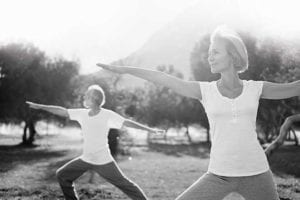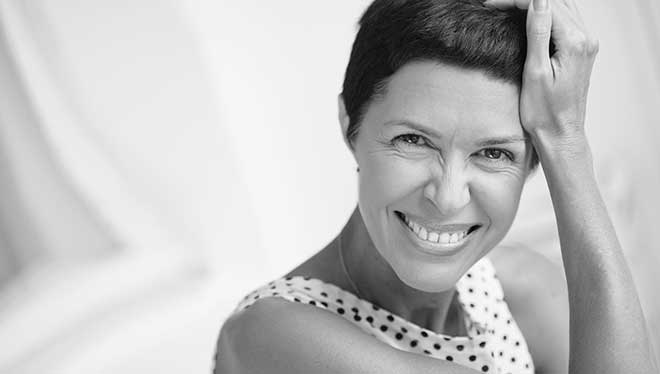Getting old may be no fun, but it beats the alternative, so the saying goes. No one enjoys being plagued by the common ailments of aging—creaky joints, arthritis, dry eye, incontinence—but at least modern medicine has provided us with remedies. As time goes by, the best attitude is improve what we can change and learn to accept the rest!
incontinence
There is nothing fashionable about incontinence. But there is some good news on that front, and it comes in the form of pills, Botox, exercise and absorbent underwear that is thin and undetectable.
accepting the unthinkable
It is so unfair. As moist parts of our aging bodies become dry, the parts that are supposed to stay dry may get wet. “The older you get, the more likely you are to see incontinence,” says Dr. Henry Lai, a urologic surgeon at Washington University School of Medicine.
Studies indicate, he says, that one in six adults may have overactive bladder, a type of incontinence. Incidence may be as high as 30 percent for middle-aged women, says Dr. Fareesa Khan of Urogynecology Consultants. Another category of the malady, stress urinary incontinence, is most common in women who have given birth. “It is likely related to a combination of altered anatomy and aging,” Khan notes.
don’t make it life-limiting
“A lot of people cannot hold it until they get to the bathroom, so they restrict their activities and social lives,” Lai says. “Before they go to a shopping mall, they map out the bathrooms. Yesterday a patient told me he can’t go out because he doesn’t want to embarrass himself by wearing a diaper and smelling like urine. Some patients are spending $100 to $200 per month buying diapers.”
But urinary incontinence can and should be treated, Khan says. “I hear people say it is normal because everybody gets older. It doesn’t have to be normal. If your symptoms are affecting your quality of life, there definitely are treatment options. If you choose to jump on it early, you probably can nip it in the bud before it becomes severe.” Incontinence There is nothing fashionable about incontinence. But there is some good news on that front, and it comes in the form of pills, Botox, exercise and absorbent underwear that is thin and undetectable.
diagnosis and prognosis
The first wave of urinary problems can arrive in middle age. “There are two types of leaking. Stress incontinence happens when you cough, sneeze or exercise,” Lai says. “It is much more common in women. As people age, the pelvic tissue is not as strong as it used to be, and physical exertion pushes urine past the urethra’s sphincter muscles.”
For women, stress incontinence is likely related to anatomical damage from childbirth, Khan adds. These anatomical changes are so common that she specializes entirely in incontinence and pelvic floor disorders, she says.
Then there is overactive bladder, or urge incontinence. “The older you get, the more likely you are to see that,” Lai says. “All of a sudden, there is a rush of urgency to get to the bathroom. Many cannot hold it.” Khan says the nerves and chemical receptors on the bladder muscle simply deteriorate with age. “Genetics, race, childbirth and lifestyle factors (smoking and obesity) play roles,” she explains.
consider your options
For overactive bladder, there are medications that can relax the bladder muscle. “They allow it to hold a bit more volume and give the patient stronger control,” Lai says. He says medications work about two-thirds of the time. “We also can do Botox injections. For about 20 years, that has been a kind of pacemaker for the bladder.”
Pelvic floor physical therapy and exercises may assist women in regaining urinary control, but Khan cautions that not all women are appropriate candidates. “The exercises can make the condition worse,” he says. “Ask a physician if they are right for you.”
For many women with stress incontinence, there is a simple, 10-minute, outpatient surgical procedure with a 90 percent success rate, Khan says. The mid-urethral sling has been subject to undeserved controversy due to problems with other surgical techniques using mesh slings, she says. “The original bladder sling has been the subject of 2,000 research studies and is still endorsed by all major medical organizations.”
age-appropriate exercise
Activity keeps joints flexible and muscles strong. It flushes the pores and keeps skin moist and glowing. It enhances the immune system and the brain while burning calories and boosting metabolism. But for seniors, the key is finding the right kind of exercise—not too stressful on the joints, but challenging enough to improve bone density, muscle mass, heart health, balance and flexibility.
 benefits galore
benefits galore
There has been a lot of research on the effects of exercise, says Michelle Villmer of Gateway Region YMCA. “Strength training creates lean mass; cardiovascular activity keeps your heart stronger so you get blood and oxygen into all the cells of your body at a better rate. Our flexibility and range of motion are very important to prevent frailness and loss of balance. Exercise even keeps your brain sharp because increasing the blood circulation keeps your brain young,” she notes.
Exercise can boost your social life, too, she adds. “You have more confidence when you exercise regularly because you feel stronger and better about yourself. And if you exercise with friends or in a club setting, you meet people doing the same things you do.”
Aging naturally involves muscle mass and strength loss, Villmer says. “The muscles lose mass and shorten, which can lead to frailty, so maintaining strength is very important, whether we do it by using hand weights, machines or exercise bands.” If not prevented through exercise, joint stiffness and muscle shortening c a n begin to affect posture and limit movement.
Strength exercises and other activities reduce the risk of falls and injuries, too.
safe for seniors
There is a wide range of things you can do for cardiovascular activity—biking, running, walking, jumping rope or a variety of machines and classes at the local gym, Villmer says. “Finding something fun is key.”
Hiking, bicycling and other whole-body activities are powerful workouts, she says. “You use a lot of muscle fibers during these activities. When you are working at a quicker rate, you’re getting your blood pumping to every muscle in your body, and that multiplies the effect,” she notes.
Exercise is known to boost the mind, too. “People who tend to stay active and take care of themselves have quicker recovery rates when they get sick,” Villmer says. “When your brain is getting all the oxygen and nutrients it needs, you can keep up with your kids and grandkids better and continue your daily activities without feeling winded.”
federal guidelines
“Being physically active can help you continue to do the things you enjoy and stay independent as you age,” advises a brochure from the National Institute on Aging. “The goal is to achieve at least 30 minutes of moderate-intensity endurance activity on most or all days of the week.”
In addition, the Institute states that regular exercise and physical activity can reduce the risk of developing some diseases and disabilities. Studies demonstrate exercise benefits for people who have arthritis, heart disease, diabetes, high blood pressure, balance problems and difficulty walking. Once you start being physically active, you’ll begin to see the following benefits, according to the Institute:
- More energy
- Improved mood and outlook
- Greater ease climbing stairs, getting in and out of the car and doing daily activities
- Less pain when you move
- Ability to get on the floor and play games with your grandchildren (and then get back up again)
- Improvement in symptoms of ongoing health conditions
- Improved sleep
dry eyes
It’s one of the most vexing aspects of aging: dry eyes. Everything loses moisture as we age, and when it comes to the eyes, we feel that discomfort all day long. What can we do to get relief?
 scratchy, gritty sensations
scratchy, gritty sensations
“Dry eyes are uncommon under age 40,” says Dr. Stephen A. Wexler, an ophthalmic surgeon at Eye Care Associates of St. Louis. “Mucous membranes tend to get drier with age, as do most lubricated parts of the body. It’s part of the natural aging process.” The National Institutes of Health estimates the prevalence of dry eye disease may be as high as 33.7 percent, depending on which study is cited, how the disease is diagnosed and which population is surveyed.
Says Dr. Jay Pepose, an ophthalmic surgeon at Pepose Vision Institute, “One theory is that testosterone plays an important role in tear production and maintaining the glands in the eyelids. As we age, testosterone levels fall in men and women.”
The eyelids, meanwhile, may be less effective at spreading tears, Wexler says. “Our lids, the windshield wipers of the eyes, tend to become more lax and less functional.”
disease or de facto?
Drought can plague the eyes for other reasons. “Autoimmune diseases can cause plugging or atrophy of the lacrimal glands,” Pepose says. “Many medications, too, can lead to dry eyes.” He adds that dry eye is sometimes exacerbated by the environment. “In the winter, some building interiors can be really dry. Some people have a mixture of dry eye and allergies, particularly in St. Louis, where pollen counts can be high.”
Finally, Pepose says, “Many patients sit at a computer all day. The computer might be at eye level, so the eyes are wide open. If you are staring at a computer, your blink rate goes down, so you are going to be more symptomatic.”
sense the symptoms
“There is not necessarily discomfort with dry eye,” Wexler says. “Often, it just affects the patient visually. The tear film that coats the surface of the eye is the first thing that light hits as it is refracted into the eye. If you don’t have a stable tear film, vision is affected.”
Up to 50 percent of patients with dry eye may not have symptoms, Pepose says. “It may be so far along that the corneal nerves on the ocular surface aren’t functioning normally. When people start to have symptoms like grittiness, burning, itching or foreign body sensations, they should seek attention. Without treatment, dry eye generally gets worse and can damage the ocular surface.”
easy on the eyes
“Dry eye is very treatable,” Wexler says. “The initial therapy consists of artificial tears.” Fish oil, flax seed oil or any type of Omega-3 fatty acids taken orally also can reduce inflammation and increase tear production, Pepose suggests. Some people have tried glasses with a seal around them to create a moisture chamber and reduce evaporation, he adds.
Prescription drops like Restasis and Xiidra turn on tear production and reduce inflammation, the doctors note. Another option, Wexler adds, is conserving tears with punctal plugs. The tiny devices are inserted into the ducts, or puncta, in the inner corners of the eyelids.
For some, the problem is the meibomian glands that secrete oil, Pepose says. “If the oil glands are clogged, the outer tears evaporate more quickly,” he explains. “LipiFlow is a device that heats the inner lid, melting wax in the glands. It’s a 12-minute procedure that may need to be repeated periodically.” Whichever treatment we choose to find relief, it’s important to realize that dry eye is a chronic condition requiring long-term treatment, Pepose says.








